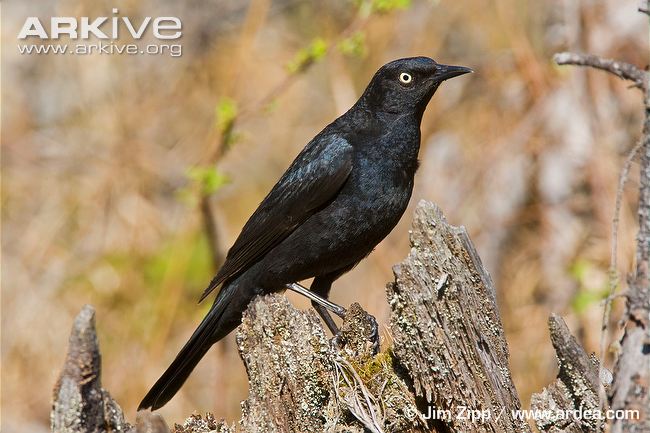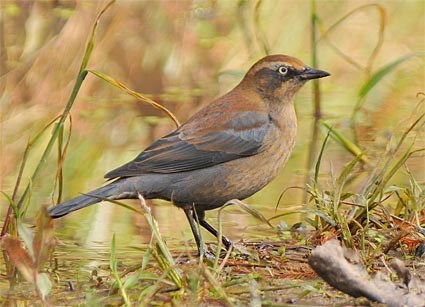
Euphagus carolinus
TAXONOMY
Turdus carolinus Mьller, 1776, Carolina. Two geographically
discrete forms recognized.
OTHER COMMON NAMES
French: Quiscale rouilleux; German: Roststдrling; Spanish:
Tordo Canadiense.
PHYSICAL CHARACTERISTICS
8–9 in (20.5–23 cm); female 1.7–2.7 oz (47–76.5 g), male
1.6–2.8 oz (46–80.5 g). Sexes similar in color. Entirely black
with a greenish or sometimes purplish gloss, a square-tipped
tail, thin bill, and pale yellow eyes. Juveniles brownish, with a
paler brown throat and stripe above the eye, and sometimes
with the black flecking on the undersides.
DISTRIBUTION
Breeds from western Alaska east across northern Yukon, central
Northwest Territories, northern Manitoba and northcentral
Labrador and Newfoundland south to southern Alaska,
northwest British Columbia, central Saskatchewan, southern
Ontario, northeastern New York, and western Massachusetts.
Winters from the northern states east of the Rockies, south to
the Gulf coast and northern Florida, west to eastern Texas.
HABITAT
Moist woodlands (primarily coniferous) and bogs. In winter,
found in open, wet woodland, pastures, and cultivated fields.
BEHAVIOR
Territorial during the breeding season. They are usually solitary
nesters, but small colonies are not infrequent in Newfoundland
and Labrador. Males defend a territory with songs
and chasing. In winter, usually found in flocks; when alarmed,
they fly to the nearest bush or tree. In winter, they may flock
with other species of blackbirds, but flocks of only rusty blackbirds
are not uncommon.
FEEDING ECOLOGY AND DIET
Forage mostly on ground or low in vegetation. Their food is
principally insects, but they will take small birds, and eat some
grain and other seeds.
REPRODUCTIVE BIOLOGY
Monogamous. The nest is a bulky cup of twigs, grass, and
other plant matter, which may be placed on the ground or as
high as 23 ft (7 m). Generally 4–5 eggs are laid in May–June.
Incubation about 14 days; fledging about 12 days. Single
brooded.
CONSERVATION STATUS
Not threatened. Widespread and common, but numbers declining.
SIGNIFICANCE TO HUMANS
None known.
Other popular Animals
Photo Gallery of - Rusty blackbird




 Animalia Life
Animalia Life